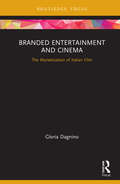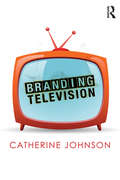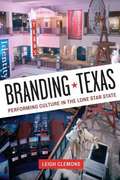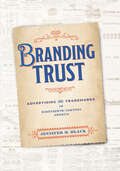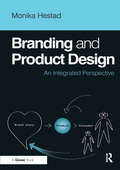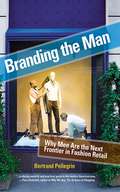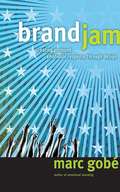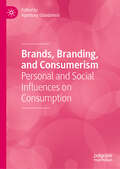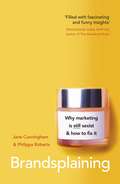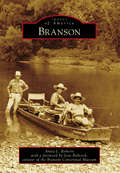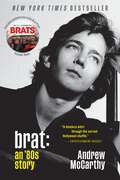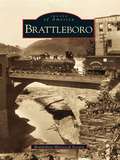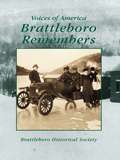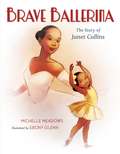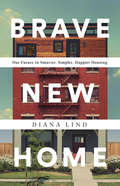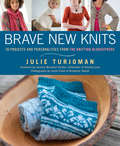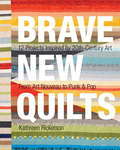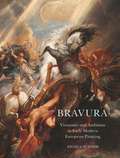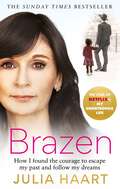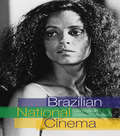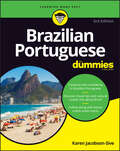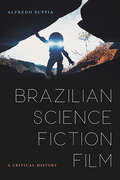- Table View
- List View
Brand-Driven City Building and the Virtualizing of Space
by Alexander GutzmerThis book is an investigation of the cultural phenomenon of branding and its transformational effects on the contemporary spatial – and urban – reality. It develops a novel understanding of the rationale behind the construction of large-scale architectural complexes that relate to corporate brands, and of its tremendous cultural effects. The author suggests that what we see today is the creation of "global mass ornaments", of a thorough ornamentalization of the entire globe. The origins of this are discussed with regard to examples of corporate brand-building from Europe and China (Autostadt Wolfsburg, BMW Welt Munich and Anting New Town). Additional cases are several simulated spaces in Berlin and the space-branding activities of companies like Apple or Prada. Theoretically, the author develops an innovative poststructuralist framework, combining ideas from Gilles Deleuze with the space philosophy of Peter Sloterdijk. He analyzes how the corporate redefinition of space makes the city enter into a mode of virtual urbanity. This idea leads to a notion of a "global urban" and, ultimately, the "global mass ornament". This concept of a global mass ornament is developed here with reference to Sloterdijk’s concept of a world of "spheres". The latter is used to understand the new mode of spatiality of mediatized spaces. The book makes the point that our world is involved in a process of mass ornamentalization that has only just begun. The concept of the global mass ornament is the first to come to grips with a culture in which branding is effectively changing the physiognomy of the earth. The global mass ornament is a banner for a cultural transformation that employs architecture, sign theory and mechanisms borrowed from traditional advertising and from social media, as well as social processes – and that we have yet to properly understand. This book is a significant step forward in this respect.
Branded Entertainment and Cinema: The Marketisation of Italian Film (Routledge Critical Advertising Studies)
by Gloria DagninoThe history of Italian cinema is mostly regarded as a history of Italian auteurs. This book takes a different standpoint, looking at Italian cinema from the perspective of an unusual, but influential actor: advertisers. From the iconic Vespa scooter and the many other Made in Italy products placed in domestic and international features, to Carosello’s early format of branded entertainment, up through the more recent brand integration cases in award-winning titles like The Great Beauty, the Italian film and advertising industries have frequently and significantly intersected, in ways that remain largely unexplored by academic research. This book contributes to fill this gap, by focusing on the economic and cultural influence that advertising and advertisers’ interests have been exerting on Italian film production between the post-war period and the 2010s. Increasingly market-oriented film policies, ongoing pressure from Hollywood competition, and the abnormal economic as well as political power held by Italian ad-funded broadcasters are among the key points addressed by the book. In addition to a macro-level political economic analysis, the book draws on exclusive interviews with film producers and promotional intermediaries to provide a meso level analysis of the practices and professional cultures of those working at the intersection of Italian film and advertising industries. Providing an in-depth yet clear and accessible overview of the political and economic dynamics driving the Italian media landscape towards unprecedented forms of marketisation, this is a valuable resource for academics and students in the fields of film and media studies, marketing, advertising, and Italian studies.
Branding New York: How a City in Crisis Was Sold to the World
by Miriam GreenbergWinner of the 2009 Robert Park Book Award for best Community and Urban Sociology book! Branding New York traces the rise of New York City as a brand and the resultant transformation of urban politics and public life. Greenberg addresses the role of "image" in urban history, showing who produces brands and how, and demonstrates the enormous consequences of branding. She shows that the branding of New York was not simply a marketing tool; rather it was a political strategy meant to legitimatize market-based solutions over social objectives.
Branding Television (Comedia)
by Catherine JohnsonBranding Television examines why and how the UK and US television industries have turned towards branding as a strategy in response to the rise of satellite, cable and digital television, and new media, such as the internet and mobile phone. This is the first book to offer a sustained critical analysis of this new cultural development. Branding Television examines the industrial, regulatory and technological changes since the 1980s in the UK and the USA that have led to the adoption of branding as broadcasters have attempted to manage the behaviour of viewers and the values associated with their channels, services and programmes in a world of increased choice and interactivity. Wide-ranging case studies drawn from commercial, public service, network and cable/satellite television (from NBC and HBO to MTV, and from BBC and Channel 4 to UKTV and Sky) analyse the role of marketing and design in branding channels and corporations, and the development of programmes as brands. Exploring both successful and controversial uses of branding, this book asks what problems there are in creating television brands and whether branding supports or undermines commercial and public service broadcasting. Branding Television extends and complicates our understanding of the changes to television over the past 30 years and of the role of branding in contemporary Western culture. It will be of particular interest to students and researchers in television studies, but also in creative industries and media and cultural studies more generally.
Branding Texas
by Leigh ClemonsAsk anyone to name an archetypal Texan, and you're likely to get a larger-than-life character from film or television (say John Wayne's Davy Crockett or J. R. Ewing of TV's Dallas) or a politician with that certain swagger (think LBJ or George W. Bush). That all of these figures are white and male and bursting with self-confidence is no accident, asserts Leigh Clemons. In this thoughtful study of what makes a "Texan," she reveals how Texan identity grew out of the history--and, even more, the myth--of the heroic deeds performed by Anglo men during the Texas Revolution and the years of the Republic and how this identity is constructed and maintained by theatre and other representational practices. Clemons looks at a wide range of venues in which "Texanness" is performed, including historic sites such as the Alamo, the battlefield at Goliad, and the San Jacinto Monument; museums such as the Bob Bullock Texas State History Museum; seasonal outdoor dramas such as Texas! at Palo Duro Canyon; films such as John Wayne's The Alamo and the IMAX's Alamo: The Price of Freedom; plays and TV shows such as the Tuna trilogy, Dallas, and King of the Hill; and the Cavalcade of Texas performance at the 1936 Texas Centennial. She persuasively demonstrates that these performances have created a Texan identity that has become a brand, a commodity that can be sold to the public and even manipulated for political purposes.
Branding Trust: Advertising and Trademarks in Nineteenth-Century America (American Business, Politics, and Society)
by Jennifer M. BlackIn the early nineteenth century, the American commercial marketplace was a chaotic, unregulated environment in which knock-offs and outright frauds thrived. Appearances could be deceiving, and entrepreneurs often relied on their personal reputations to close deals and make sales. Rapid industrialization and expanding trade routes opened new markets with enormous potential, but how could distant merchants convince potential customers, whom they had never met, that they could be trusted? Through wide-ranging visual and textual evidence, including a robust selection of early advertisements, Branding Trust tells the story of how advertising evolved to meet these challenges, tracing the themes of character and class as they intertwined with and influenced graphic design, trademark law, and ideas about ethical business practice in the United States.As early as the 1830s, printers, advertising agents, and manufacturers collaborated to devise new ways to advertise goods. They used eye-catching designs and fonts to grab viewers’ attention and wove together meaningful images and prose to gain the public’s trust. At the same time, manufacturers took legal steps to safeguard their intellectual property, formulating new ways to protect their brands by taking legal action against counterfeits and frauds. By the end of the nineteenth century, these advertising and legal strategies came together to form the primary components of modern branding: demonstrating character, protecting goodwill, entertaining viewers to build rapport, and deploying the latest graphic innovations in print. Trademarks became the symbols that embodied these ideas—in print, in the law, and to the public.Branding Trust thus identifies and explains the visual rhetoric of trust and legitimacy that has come to reign over American capitalism. Though the 1920s has often been held up as the birth of modern advertising, Jennifer M. Black argues that advertising professionals had in fact learned how to navigate public relations over the previous century by adapting the language, imagery, and ideas of the American middle class.
Branding and Product Design: An Integrated Perspective
by Monika HestadWhy do winning brands appear to be more creative and authentic than less successful ones? Despite the strong link between famous brands and the products sold under their name, there is still a gap in understanding the relationship between product design and brand-building - Monika Hestad plugs that gap. Branding and Product Design discusses key questions about the link between product and brand and about design processes and innovation. It examines these questions on both macro and micro levels and provides the reader with tools to help understand the role of products in building a brand, and how to bring the brand and the product design process together. These are based on the author's research into branding and product design, her years of teaching these topics, and her own industrial practice. Qualitative interviews delivering an 'insider' perspective on major brands bring abstract concepts to life. The book includes case studies from well-known and up-and-coming brands and will prove invaluable to design practitioners, marketers, managers and other professionals working close to designers. It will also benefit those teaching and studying, particularly if they are involved in the new higher education programmes where business schools and design schools are co-operating to reflect the intersection between design and branding.
Branding the Man: Why Men Are the Next Frontier in Fashion Retail
by Bertrand PellegrinMen are purchasing more clothes, shoes, health and beauty products, and personal care services than ever before. The world of men's retail has remained a kind of bug in amber, frozen in time, with the same century-old style of merchandising and selling. A store must not simply provide, but educate the male customer, who is growing hungry for something more than the usual Blue Plate Special of khakis and polo shirts. To better attract this new wave of interested consumers, products in the U.S. must be merchandised and sold in a completely different manner. The design and branding of a man's store ought to make men want to go shopping. Branding the Man offers retailers, buyers, and marketers strategic solutions to revolutionize men's retail via some relatively simple conceptual strategies. Author Bertrand Pellegrin utilizes his years as a retail strategist to help retailers understand classic men's environments-ones where men are most naturally inclined to spend time-and leverage the opportunities which arise from these "comfort zones" to engage and sell to the male customer. Branding the Man immerses the reader in a discussion of men's retail environments spanning every level: store design, buying/sourcing, merchandising, marketing and advertising, and promotion and lays out a blueprint for how men can be developed as the "next frontier" in retail.
Brandjam: Humanizing Brands Through Emotional Design
by Marc GobeBrandjam, the follow-up to the groundbreaking best-seller Emotional Branding, presents a powerful new concept from renowned designer and business guru Mark Gobe. The Brandjam concept is about innovation, intuition, and risk. Gobe explains how design is the "instrument" companies can use for jazzing up a brand-how design puts the face on the brand and creates an irresistible message that connects buyers to the product in a visceral way. Using jazz as his metaphor, he shows how the instinctive nature of the creative process leads to unusual solutions that make people gravitate toward a brand and make brands resonate with people by bringing more joy into their lives. It explores how design represents the personality of a company and provides its window to the world. Brandjam is an inspiration for brands and people as it reveals the transforming impact brands have on their audience. Follow-up to Emotional Branding-50,000 copies sold in nine languages Insider's look at creating powerful, compelling brands and identities Exciting new ideas for using design to drive consumers to embrace brands
Brands, Branding, and Consumerism: Personal and Social Influences on Consumption
by Ayantunji GbadamosiThis book focuses on exploring the dynamics of brands and branding in relation to individual consumers and societal members’ behaviour. The term consumerism is often used in two different contexts which are: (1) the dynamics of consumption that delineate consumers and link them, and (2) the notion of consumer movement that advocates the rights of the consumers against the powers of businesses. Both of these are explored in various ways in the book. The chapters address different aspects of consumption activities in relation to branding encapsulating personal influences on consumption such as motivation, perception, learning, attitude, the self, and personality. Similarly, chapters on how social settings influence brand consumption ranging from culture, sub-culture, and reference groups are incorporated into the book. Apart from luxury brand consumption, social media marketing, and consumer protection in relation to branding context, other contemporary topics such as ethics, and sustainable consumption in relation to branding, are also covered with regard to brands and branding in the book.
Brandsplaining: Why Marketing is (Still) Sexist and How to Fix It
by Jane Cunningham Philippa Roberts'It's high time we expose and remedy the pseudo-feminist marketing malarkey holding women back under the guise of empowerment' Amanda Montell, author of Wordslut________________Brands profit by telling women who they are and how to be. Now they've discovered feminism and are hell bent on selling 'fempowerment' back to us. But behind the go-girl slogans and the viral hash-tags has anything really changed?In Brandsplaining, Jane Cunningham and Philippa Roberts expose the monumental gap that exists between the women that appear in the media around us and the women we really are. Their research reveals how our experiences, wants and needs - in all forms - are ignored and misrepresented by an industry that fails to understand us.They propose a radical solution to resolve this once and for all: an innovative framework for marketing that is fresh, exciting, and - at last - sexism-free.________________'If you think we've moved on from 'Good Girl' to 'Go Girl', think again!' Professor Gina Rippon, author of The Gendered Brain'An outrageously important book. Erudite, funny, and deeply engaging -- with no condescension or bullshit' Dr Aarathi Prasad, author of Like A Virgin'This book has the power to change the way we see the world' Sophie Devonshire, CEO, The Marketing Society and author of Superfast
Branson
by Anita L. Roberts Jean BabcockIn 1939, Branson was described as "the paradise of the Ozarks--the playground of America." Originally home to the Osage, the harsh rocky terrain made homesteading difficult. The Ozarks's wilderness became a hideout for bushwhackers following the Civil War. The masked "Bald Knobbers" developed as vigilantes to defend mountain families. Today, the "Baldknobbers" are known as Branson's first musical show. In 1894, tours began in Marble Cave, one of 8,000 Ozarks caves. Now known as Marvel Cave, it boasts the largest cave entrance room in the United States and remains a main attraction at Silver Dollar City's theme park. Many visitors are lured by the natural beauty, healthful atmosphere, and recreational activities offered in the Ozarks. Harold Bell Wright penned The Shepherd of the Hills while recuperating here at the beginning of the 20th century. A wave of tourism to the Branson area followed its 1907 publication. Today, the "Live Entertainment Capital of the World" welcomes more than eight million visitors yearly.
Brat: An '80s Story
by Andrew McCarthyFans of Patti Smith's Just Kids and Rob Lowe's Stories I Only Tell My Friends will love this beautifully written, entertaining, and emotionally honest memoir by an actor, director, and author who found his start as an 80s Brat pack member -- the inspiration for the Hulu documentary Brats, written and directed by Andrew McCarthy. Most people know Andrew McCarthy from his movie roles in Pretty in Pink, St. Elmo's Fire, Weekend at Bernie's, and Less than Zero, and as a charter member of Hollywood's Brat Pack. That iconic group of ingenues and heartthrobs included Rob Lowe, Molly Ringwald, Emilio Estevez, and Demi Moore, and has come to represent both a genre of film and an era of pop culture. In his memoir Brat: An '80s Story, McCarthy focuses his gaze on that singular moment in time. The result is a revealing look at coming of age in a maelstrom, reckoning with conflicted ambition, innocence, addiction, and masculinity. New York City of the 1980s is brought to vivid life in these pages, from scoring loose joints in Washington Square Park to skipping school in favor of the dark revival houses of the Village where he fell in love with the movies that would change his life. Filled with personal revelations of innocence lost to heady days in Hollywood with John Hughes and an iconic cast of characters, Brat is a surprising and intimate story of an outsider caught up in a most unwitting success.
Brattleboro
by Brattleboro Historical SocietyBrattleboro, lies in the southeast corner of Vermont, just nine miles north of the Massachusetts border and directly across the Connecticut River from New Hampshire. The community developed in the 1760s, when European American settlers established homes in the river valley. Brattleboro was ideal for settlement because of its topography. The Whetstone Brook, which runs from the foothills of the Green Mountains through Brattleboro, provided a major source of waterpower, and the Connecticut River offered an ideal transportation route for sending finished products via flat-bottomed boat to market in southern New England and New York. Brattleboro presents the story of its people, who from the beginning have exhibited and benefited from a positive philosophy toward life. In the mid-1800s, railroad service came to the area and Brattleboro developed as a center for commerce, health spas, and literary activities. Factories manufacturing organs, toys, and furniture thrived. Printing and publishing industries, as well as literary societies flourished. Hotels opened, and visitors arrived to do business or just to avail themselves of the town's many advantages. To this day, the area continues to enjoy a stable economy.
Brattleboro Remembers
by Brattleboro Historical SocietyFamily stories are a part of oral history. They are told to inform younger generations about events heretofore not recorded. Brattleboro Remembers is a collection of such stories accompanied by the rich assortment of historical photographs that stirred these memories of earlier days in the southeastern corner of Vermont.Brattleboro Remembers emerged as a result of writing workshops sponsored by the Brattleboro Historical Society and made possible by a grant from the Council on Aging for Southeastern Vermont. The workshops, facilitated by poet and writing partner Verandah Porche, took place on winter Sunday afternoons. The walls of the room in which the group met were covered with copies of historical photographs. The workshop participants, most of whom still live in Brattleboro, selected photographs that brought back strong recollections. After studying an image, they wrote autobiographical pieces based on what came to mind. For those shy about putting pen to paper, volunteer scribes were on hand to listen to the stories and help the participants get their reminiscences down on paper.
Brave Ballerina: The Story of Janet Collins (Who Did It First?)
by Michelle MeadowsA lyrical picture book biography of Janet Collins, the first African American principal dancer at the Metropolitan Opera House. Janet Collins wanted to be a ballerina in the 1930s and 40s, a time when racial segregation was widespread in the United States. Janet pursued dance with a passion, despite being rejected from discriminatory dance schools. When she was accepted into the Ballet Russe de Monte Carlo as a teenager on the condition that she paint her skin white for performances, Janet refused. She continued to go after her dreams, never compromising her values along the way. From her early childhood lessons to the height of her success as the first African American prima ballerina in the Metropolitan Opera, Brave Ballerina is the story of a remarkable pioneer as told by Michelle Meadows, with fantastic illustrations from Ebony Glenn.
Brave New Home: Our Future in Smarter, Simpler, Happier Housing
by Diana LindA smart, provocative look at how the American Dream of single-family homes, white picket fences and two-car garages became a lonely, overpriced nightmare, and how new trends in housing can help us live better. Over the past century, American demographics and social norms have shifted dramatically. More people are living alone, marrying later in life, and having smaller families. At the same time, their lifestyles are changing, whether by choice or by force, to become more virtual, more mobile, and less stable. But despite the ways that today's America is different and more diverse, housing still looks stuck in the 1950s. In Brave New Home, Diana Lind shows why a country full of single-family houses is bad for us and our planet, and details the new efforts underway that better reflect the way we live now, to ensure that the way we live next is both less lonely and more affordable. Lind takes readers into the homes and communities that are seeking alternatives to the American norm, from multi-generational living, in-law suites, and co-living to microapartments, tiny houses, and new rural communities.Drawing on Lind's expertise and the stories of Americans caught in or forging their own paths outside of our cookie-cutter housing trap, Brave New Home offers a diagnosis of the current crisis in American housing and a radical re-imagining of the possibilities of housing.
Brave New Knits: 26 Projects and Personalities from the Knitting Blogosphere
by Julie TurjomanBrave New Knits by Julie Turjoman, cofounder of Ravelry.com is the first book to celebrate the convergence of traditional hand-knitting and modern technology. The Internet has made it possible for the knitting community to connect through photos, pattern-sharing, and blogs that document the knitting projects and passions of dozens of designers and enthusiasts. With a Foreword written by Jessica Marshall Forbes, co-founder of Ravelry.com, Brave New Knits includes 26 must-have garment and accessory patterns, all gorgeously photographed by knitting celebrity Jared Flood of Brooklyn Tweed. Contributors range from established designers like Norah Gaughan, Wendy Bernard, Anne Hanson, and knitgrrl Shannon Okey, to rising stars such as Melissa Wehrle, Connie Chang Chinchio, and Hilary Smith Callis. In-depth interviews with the designers reveal their design philosophy and passions. From shapely sweaters and delicate shawls to fingerless gloves and stylish hats, each of the knitted designs features detailed directions and charts to inspire both the beginner and experienced knitter.
Brave New Quilts: 12 Projects Inspired by 20th-Century Art From Art Nouveau to Punk & Pop
by Kathreen RicketsonThe beloved quilt artist explores the use of line, color, motif, and text in this quilting guide featuring 12 projects inspired by modern art movements.Kathreen Ricketson was one of Australia’s most popular modern quilt artists and bloggers. In Brave New Quilts, she combines her fine art background with her love of craft to offer a series of quilts evoking the aesthetics of Art Deco, Bauhaus, Abstract Expressionism, and even Dada. Each chapter focuses on a different design principle with 3 quilt projects presented with 2 alternate design options.Kathreen shares a historical overview of each art movement, giving essential context to each project. A must-have for fans of the modern quilt movement, Brave New Quilts includes expert information on color, fabric selection, inspiration, and mood boards. A comprehensive appendix and in-depth information on tools and finishing techniques round out this inspiring book.
Brave New Workshop: Promiscuous Hostility and Laughs in the Land of Loons (Landmarks)
by Rob HubbardIn 1958, former circus aerialist Dudley Riggs opened a Minneapolis coffeehouse with a stage for performers and created an American comedic institution. What started as a way to draw customers on slow nights became the Brave New Workshop, a comedy theater sinking its satirical talons deep into the culture of Minneapolis-St. Paul for over half a century. This theater helped launch the careers of many talented performers, including satirist-turned-senator Al Franken and his Saturday Night Live partner in comedy, Tom Davis, as well as comedian Louie Anderson, Daily Show co-creator Lizz Winstead, screenwriter Pat Proft of the Naked Gun films and many others. Author Rob Hubbard tells the story of the hilarity, irreverence and imagination of the Brave New Workshop--a funhouse mirror to the world around it."If you've lived in Chicago, you know what Second City is. If you've lived in the Twin Cities, you know what the Brave New Workshop is. Founder Dudley Riggs and the Brave New Workshop played a big part in my comedy career. Read the real history of this company and the actors and writers from it who have influenced comedy on television and the big screen for over 50 years."- Louie Anderson
Bravura: Virtuosity and Ambition in Early Modern European Painting
by Nicola SuthorThe first major history of the bravura movement in European paintingThe painterly style known as bravura emerged in sixteenth-century Venice and spread throughout Europe during the seventeenth century. While earlier artistic movements presented a polished image of the artist by downplaying the creative process, bravura celebrated a painter’s distinct materials, virtuosic execution, and theatrical showmanship. This resulted in the further development of innovative techniques and a popular understanding of the artist as a weapon-wielding acrobat, impetuous wunderkind, and daring rebel. In Bravura, Nicola Suthor offers the first in-depth consideration of bravura as an artistic and cultural phenomenon. Through history, etymology, and in-depth analysis of works by such important painters as Franҫois Boucher, Caravaggio, Francisco Goya, Frans Hals, Peter Paul Rubens, Tintoretto, and Diego Velázquez, Suthor explores the key elements defining bravura’s richness and power.Suthor delves into how bravura’s unique and groundbreaking methods—visible brushstrokes, sharp chiaroscuro, severe foreshortening of the body, and other forms of visual emphasis—cause viewers to feel intensely the artist’s touch. Examining bravura’s etymological history, she traces the term’s associations with courage, boldness, spontaneity, imperiousness, and arrogance, as well as its links to fencing, swordsmanship, henchmen, mercenaries, and street thugs. Suthor discusses the personality cult of the transgressive, self-taught, antisocial genius, and the ways in which bravura artists, through their stunning displays of skill, sought applause and admiration.Filled with captivating images by painters testing the traditional boundaries of aesthetic excellence, Bravura raises important questions about artistic performance and what it means to create art.
Brazen: The sensational memoir from the star of Netflix's My Unorthodox Life
by Julia HaartFrom the star of Netflix's My Unorthodox Life, a riveting, inspiring memoir. Julia Haart tells the story of her extraordinary journey, from leaving an ultra-Orthodox Jewish community to her rise from housewife to shoe designer, to CEO and co-owner of the modelling agency Elite World Group.'An irresistible read . . . Written with great intensity and rare candor, Brazen is a story of longing for more and manifesting that vision.' TOMMY HILFIGER'I congratulate Haart on the show and book, both of which I enjoyed ... Haart is a hustler, a born entrepreneur, charismatic enough to attract investment like a pop ingenue attracts talent scouts, a "fighter" (her words) and a woman who loves and understands fashion.' POLLY VERNON, THE TIMES MAGAZINEEver since she was a child, every aspect of Julia Haart's life - what she wore, what she ate, what she thought - was controlled by the rules of ultra-Orthodox Judaism. At nineteen, after a lifetime spent caring for her seven younger siblings, she was married off to a man she barely knew. For the next twenty-three years, her marriage would rule her life.Eventually, when Haart's youngest daughter, Miriam, started to innocently question why she wasn't allowed to sing in public, run in shorts, or ride a bike without being covered from neck to knee, Haart reached a breaking point. She knew that if she didn't find a way to leave, her daughters would be forced into the same unending servitude.So Haart created a double life. In the ultra- Orthodox world, clothing has one purpose - to cover the body, head to toe - and giving any more thought than that to one's appearance is considered sinful, an affront to God. But when no one was looking, Haart would pour over fashion magazines and sketch designs for the clothes she dreamed about wearing in the world beyond her Orthodox suburb. She started preparing for her escape by educating herself and creating a 'freedom' fund. At the age of forty-two, she finally mustered the courage to flee.Within a week of her escape, Haart founded a shoe brand, and within nine months, she was at Paris Fashion Week. Just a few years later, she was named creative director of La Perla. Soon she would become co-owner and CEO of Elite World Group and one of the most powerful people in fashion. Along the way, her four children - Batsheva, Shlomo, Miriam and Aron - have not only accepted but embraced her transformation.Propulsive and unforgettable, Haart's story is the journey from a world of 'no' to a world of 'yes', and an inspiration for women everywhere to find their freedom, their purpose and their voice.'Julia lives her life with an exhilarating fervour that's contagious to anyone lucky enough to be around her. Never willing to accept the status quo, time and again she has fought for her place in the world and demanded her seat at the table. I'm incredibly inspired by her stories, which are always told with honesty and heart. This book is a must read!'COCO ROCHA'Julia Haart is a hustler. Her story is an inspiring, believe-in-your-dreams, never-give-up, anything-in-life-is-possible story of hope. Run, don't walk, to get this book!'LISA RINNA
Brazilian National Cinema (National Cinemas)
by Lisa Shaw Stephanie DennisonBrazilian cinema is one of the most influential national cinemas in Latin America and this wide-ranging study traces the evolution of Brazilian film from the silent era to the present day, including detailed studies of more recent international box-office hits, such as Central Station (1998) and City of God (2002). Brazilian National Cinema gives due importance to traditionally overlooked aspects of Brazilian cinema, such as popular genres, ranging from musical comedies (the chanchada) to soft-core porn films (the pornochanchada) and horror films, and also provides a fresh approach to the internationally acclaimed avant-garde Cinema Novo of the 1960s. Lisa Shaw and Stephanie Dennison apply recent theories on stardom, particularly relating to issues of ethnicity, race and gender, to both well-known Brazilian performers, such as Carmen Miranda and Sonia Braga, and lesser known domestic icons, such as the Afro-Brazilian comic actor, Grande Otelo (Big Othello), and the uberblonde children’s TV and film star, and media mogul, Xuxa. This timely addition to the National Cinemas series provides a comprehensive overview of the relationship between Brazilian cinema and issues of national and cultural identity.
Brazilian Portuguese For Dummies
by Karen Jacobson-SiveLanguage learning is easy with Dummies Brazilian Portuguese For Dummies can help you achieve your goals of learning another language. Traveling to Brazil? Taking a class in school? Want to meet people and pick up a new hobby? Just curious about the sixth most spoken language in the world? We&’ve got you covered, with easy-to-follow lessons on the basics, plus phrases and topics you need to know, like greetings, travel phrases, business phrases, numbers and measurements, and social media. Add speaking Portuguese to the long list of cool things you can do—with the help of Brazilian Portuguese For Dummies. Start from the beginning and learn the very basics of Brazilian Portuguese Practice authentic phrases for travel, business, and communicating online Perfect your pronunciation with bonus audio tracks, and discover fun facts about Brazilian culture Get recommendations for movies, travel tips, and moreWhether you&’re studying Portuguese for business, school, or pleasure, Dummies is the best guide for getting started with this beautiful language.
Brazilian Science Fiction Film: A Critical History (SUNY series in Latin American Cinema)
by Alredo SuppiaThis book offers a pioneering critical history of Brazilian science fiction (SF) cinema, from its first appearances in the mid-twentieth century to the present. Though frequently overlooked by scholars, SF cinema from the Global South has reinvigorated the genre in recent decades. In this comprehensive study—the first of its kind in either English or Portuguese—Alfredo Suppia draws out the unique features and universal resonance of SF film in Brazil, a country that has fittingly been called "the land of the future." In Suppia's analysis, Brazilian SF stems from and responds to a long history of inequality in which everyday reality has often resembled a movie-like dystopia. Analyzing both short and feature films in the context of social, political, and economic transformations, Suppia rethinks SF film in general from a southern perspective.

